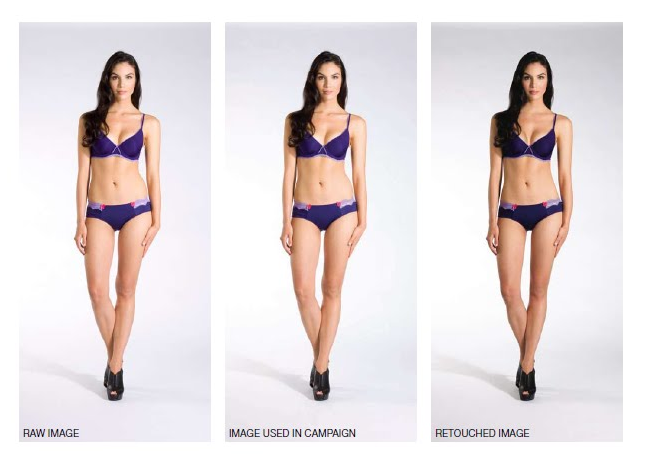In the Blog
Jacob stops some forms of retouching, still uses typical models

Canadian retailer Jacob shows off its new retouching policy in fall campaign. (JACOB)
Although fashion retailer Jacob announced last week that it will no longer alter the size of models’ bodies in its advertising images, does this really mean the company is committed to promoting realistic images of women’s bodies? Or, is the company simply peddling a body positive approach in an attempt to sell more merchandise?
Jacob explained the move in a statement on the company’s website:
“As a socially responsible company, JACOB has always made an effort to promote a healthy image of the female body. By adopting an official policy and broadcasting it publicly, we hope to reverse the trend in digital photo manipulation that has become excessive in our industry,” says spokesperson and Communications Director Cristelle Basmaji.
That being said, the company hasn’t dropped using all forms of photoshopping. The statement continues:
However, JACOB is not against all forms of touch-ups. Certain digital enhancements cannot be avoided in order to produce an image the size that is required for advertising. In all transparency, JACOB will continue to retouch its photos in some regards, as there will always be a need to calibrate colours for better product representation and to even out skin tone or erase tattoos and scars.
It’s not clear whether this means cellulite or stretch marks are going to be retouched, but since scars are going to disappear, I’d guess they would unfortunately be wiped away as well.
Jacob’s campaign promoting the new retouching policy shows three versions of one model’s image: the raw image, the image used in the company’s advertising, and the retouched image that would have been previously used.
When I first saw the three images side by side, I honestly couldn’t tell the difference between them. After scrutinizing the model’s tall, thin and conventionally attractive appearance in each for a few minutes, I finally noticed something. The third image has more strongly defined cleavage, a whittled hip and thinner thighs. Great! Jacob will no longer artificially transform women’s bodies in these ways, but how much does it matter if all models used in campaigns fit a very narrow conception of female beauty?
Don’t get me wrong, I think it’s a step in the right direction, and I commend Jacob’s transparency in disclosing what the company will and will not digitally alter. It still smells a little funny to me.
It strikes me as similar to how certain businesses use breast cancer fundraising as a means of making money. Ashley Michelle Papon at Global Shift helps unpack this idea in her article “Fetishizing the Good Cause”:
Courtesy of the Susan G. Komen [Breast Cancer] Foundation and any number of organizations dedicated to eradicating breast cancer, consumers have the option to “Think Pink” on everything from skin cream to baby toys. Even fast food has gotten into the fray, with Kentucky Fried Chicken partnering with the Komen Foundation in April as part of their “Buckets for the Cure” campaign. While it may sound incredulous that an organization dedicated to a pressing women’s health concern would willingly partner with restaurant chain renowned for deep-frying their entrees, the poorly thought-out marital misstep between the Komen Foundation and the Colonel’s legacy proves one overwhelming truth: breast cancer sells.
Papon points out the hypocrisy of a fast food chain teaming up with a breast cancer foundation, and in some ways it mirrors how Jacob is expressing feminist values but is perhaps not going all the way in espousing them. If Jacob is only going to use models and models’ images that appear pretty perfect in society’s eyes anyway, should we all be thinking, “Oh, big whoop?”



